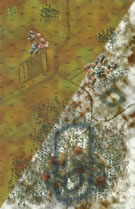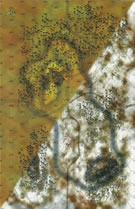|
|
|
Total |
| Side 1 |
1 |
| Draw |
0 |
| Side 2 |
0 |
|
Total |
| Side 1 |
1 |
| Draw |
0 |
| Side 2 |
0 |
|
Total |
| Side 1 |
0 |
| Draw |
0 |
| Side 2 |
0 |
|
| Overall Rating, 1 vote |
|---|
|
|
|
Scenario Rank:
--- of 958 |
| Parent Game |
Land Cruisers |
| Historicity |
Alt-History |
| Date |
1940-10-05 |
| Start Time |
06:00 |
| Turn Count |
32 |
| Visibility |
Day |
| Counters |
158 |
| Net Morale |
0 |
| Net Initiative |
2 |
| Maps |
3: 22, 23, 25 |
| Layout Dimensions |
129 x 28 cm
51 x 11 in |
| Play Bounty |
197 |
| AAR Bounty |
222 |
| Total Plays |
1 |
| Total AARs |
0 |
|
Introduction
|
|
With all eight Land Cruisers now repaired and ready for action, the Germans renewed their attack on the French 26th Infantry Division on the following morning. The French still had no answer for the giant machines, but no longer panicked at the sight of them. The Land Cruisers had been designed to break through entrenched enemy positions, not to fight enemy tanks, and now they could prove their worth.
|
|
Conclusion
|
|
Massive firepower concentrated in a small area made a difference. Despite fierce French resistance, the Land Cruisers smashed through the French line and rolled up its open flanks, inflicting massive losses on the infantry and smashing flat several artillery batteries. It was one of the very few positive outcomes in a very bleak situation for Imperial Germany, as the Kaiser weighed the moral question of using poison gas to stop the invasion.
|
Display Relevant AFV Rules
| AFV Rules Pertaining to this Scenario's Order of Battle |
- Vulnerable to results on the Assault Combat Chart (7.25, 7.63, ACC), and may be attacked by Anti-Tank fire (11.2, DFT). Anti-Tank fire only affects the individual unit fired upon (7.62, 11.0).
- AFV's are activated by tank leaders (3.2, 3.3, 5.42, 6.8).
They may also be activated as part of an initial activating stack, but if activated in this way would need a tank
leader in order to carry out combat movement.
- AFV's do not block Direct Fire (10.1).
- Full-strength AFV's with "armor efficiency" may make two anti-tank (AT) fire attacks per turn
(either in their action segment or during opportunity fire) if they have AT fire values of 0 or more
(11.2).
- Each unit with an AT fire value of 2 or more may fire at targets at a distance of between 100% and 150% of its
printed AT range. It does so at half its AT fire value. (11.3)
- Efficient and non-efficient AFV's may conduct two opportunity fires per turn if using direct fire
(7.44, 7.64).
Units with both Direct and AT Fire values may use either type of fire in the same turn as their opportunity fire,
but not both (7.22, 13.0).
Units which can take opportunity fire twice per turn do not have to target the same unit both times (13.0).
- Demoralized AFV's are not required to flee from units that do not have AT fire values (14.3).
- Place a Wreck marker when an AFV is eliminated in a bridge or town hex (16.3).
- AFV's do not benefit from Entrenchments (16.42).
- AFV's may Dig In (16.2).
- Closed-top AFV's: Immune to M, M1 and M2 results on Direct and Bombardment Fire Tables. Do not take step losses from Direct or Bombardment Fire. If X or #X result on Fire Table, make M morale check instead (7.25, 7.41, 7.61, BT, DFT).
- Closed-top AFV's: Provide the +1 modifier on the Assault Table when combined with infantry. (Modifier only applies to Germans in all scenarios; Soviet Guards in scenarios taking place after 1942; Polish, US and Commonwealth in scenarios taking place after 1943.) (ACC)
- Tank: all are closed-top and provide the +1 Assault bonus, when applicable
|
Imperial Germany Order of Battle
| 1 Errata Item |

|
In 1940: Fall of France, the units show Direct Fire. All units are Indirect Fire.
|


 LaCr008
LaCr008 




































